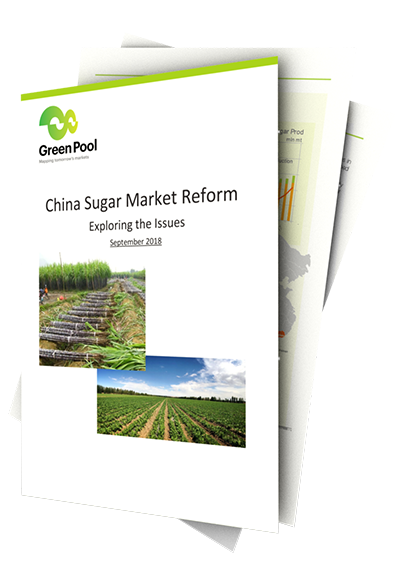China Sugar Market Reform
Exploring The Issues
September 2018

China is a major producer, consumer and importer of sugar in global terms. China’s sugar market has also seen substantial policy changes in the past 3-5 years, with important implications for both its domestic and the global market. Green Pool, as an independent market researcher, has been observing these market developments and reporting on them for many years. However, given the extent of the recent developments, the potential for changes and corresponding implications, we thought it merited a deeper investigation into some of the proposed changes being discussed within the Chinese sugar industry than is available in our regular daily, weekly or monthly subscription publications.
This study was produced in collaboration with Lindsay Jolly who, until recently, was a Senior Economist at the International Sugar Organization (ISO) in London. It covers 35 pages, including 5 maps, 10 tables and 43 charts and seeks to explore, amongst other things, the following main themes:
Why China is such a high cost producer of sugar – from both the cane and beet industry perspectives – and what does this mean?
The cost of China’s sugar production versus globally efficient producers is a (if not, “the”) major underlying problem since it is the government’s regulatory framework on China’s internal market which then compensates mills to process high set-priced cane. This, in turn, sets the scene for the now endemic smuggling of sugar into China - with major implications for both the domestic and world markets.
High prices and large stockpiles in China are not unique to sugar – this has occurred in other Chinese agricultural industries as well, most notably in cotton and corn. What lessons can be learned from those markets when the government was eventually forced to act to bring their domestic market prices more in line with global markets?
Could similar reforms be implemented in the sugar industry? If so, what scale of change is possible, and what are the likely flow through implications for the sugar sector?
As the internal price support is closely linked to sugar import policy to maintain price levels, we argue that both need to be addressed simultaneously. This report examines these issues and possible solutions to set the industry on a firmer footing, with a more
We concluded by discussing 3 potential scenarios where farmers are given a direct subsidy in place of the current distortive cane (and beet) pricing regulation and their potential implications.
List Of Contents
- Executive Summary
- China Sugar – a high cost production sector needing reform
- Regulated Prices for Cane
- Land tenure system enshrines high cane prices
- Cane sector can’t lower costs without land reform
- Beet sector smaller but more efficient
- Sugar Price – too high, too often
- Prices ease on back of global surplus and illicit smuggling
- High prices and demand destruction
- Sugar demand hurt by high price environment
- Sugar offtake Cannibalised by HFS
- Global intensive sweetener powerhouse
- High sugar prices heighten competition from imports
- Sugar Policy – the regulatory revolving door
- Sugar trade policy 101
- Government forced to step-up barriers to sugar trade
- Safeguard duties: take 1
- Import safeguards didn’t do their job
- Safeguard duties: take 2
- Smuggled Sugar: the elephant in the policy room
- Government stockholding: part of the problem
- Coastal Refiners: symptom of dysfunctional sugar policy
- China’s regulatory revolving door
- Agriculture Sector Reform – lessons from corn and cotton
- Corn stocks’ blow-out drives reform
- Cotton: Even bigger stocks blow-out forces reform
- Nation-wide price support supplanted by direct payments
- De-Stocking
- Lessons for sugar?
- A New Broom for China Sugar Regulation
- Production Subsidies appear a better choice
- Import parity benchmark but safeguard duties will have to go
- Smuggling Incentive can be Quashed
- The Rippling Pool – how regulatory change could work
- Sugar Production costs tumble
- Domestic Market Values Dip in Unison
- Import margins squeezed
- Smuggling incentives take a hit
- Government tariff revenue upped
- HFS could lose out with a swing back to sugar
- Appendices
- China Sugar Balance
- China Cane Sugar Sector
- China Beet Sugar Sector
- China and HIS
- Costs of Production
- Import Parity Prices and Margins


